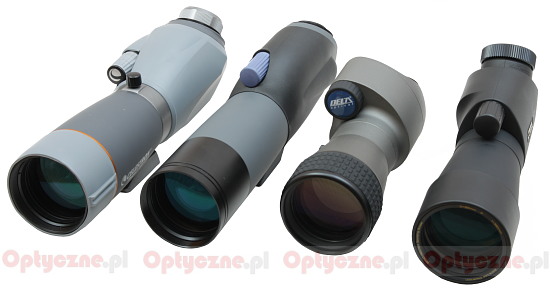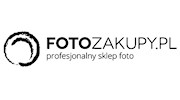Review of four 65 ED spotting scopes
6. Summary
 |
Already such a simple test of four small spotting scopes proved several important points. First of all it is obvious you have quite a wide choice - even if you decide to buy the cheapest Acuter or not much more expensive Delta Optical you get a piece of equipment with which undoubtedly you will have a lot of fun. A spotting scope like that is a perfect device to be taken on longer or shorter trips – small and handy but offering you plenty of possibilities. It will also perform well as a stationary instrument positioned on your balcony or terrace. It can be used to observe birds or bigger animals, make you acquainted with the most interesting objects of the night sky and also will allow you to observe planes (also the voyeurism plain and simple not excluded). You get quite a lot, taking into account the price and the dimensions.
It is not a surprise that with the increase of spending you can get even more. The possibilities of the cheapest Acuter are just few – you are limited to the brand-name eyepiece because its mount is too small for 1.25-inch devices. What’s more, at the maximum magnification which is optically the most demanding, the Acuter fares weakly. The casing itself also shows some shortcomings – it doesn’t feature an extendable dew shield, the focusing wheel doesn’t have a double gear and the tripod adapter is immobile so you can’t turn the spotting scope around. In such a situation you shouldn’t wonder we recommend adding those 100 PLN (25 Euro) more and buying the Delta Optical Titanium. Here you get a dew shield, you can turn the device around and you can use other 1.25-inch eyepieces, although not without small problems.
Please Support UsIf you enjoy our reviews and articles, and you want us to continue our work please, support our website by donating through PayPal. The funds are going to be used for paying our editorial team, renting servers, and equipping our testing studio; only that way we will be able to continue providing you interesting content for free. |
- - - - - - - - - - - - - - - - - - - - - - - - - - - - - - - - - - - - - - - - - - - - - - - -
What’s more, the Delta is optically a lot better than the Acuter; in many categories it can compete with the more expensive Celestron and Pentax without any problems.
When it comes to the optics, perhaps the biggest impression was made the Celestron Regal. A huge casing with big prisms and real fluorite in the objective lens make themselves felt – chromatic aberration or astigmatism are corrected very well here. In fact this spotting scope has everything a piece of equipment should have in this class: good optics, an universal 1.25-inch mount, a focusing wheel with a double gear and a dew shield. However, there are three problems. First: currently you must pay for it almost two times as much as for the Acuter or the Delta. Second: the dimensions – the Regal 65ED is more like an 80-85 mm class device, really big and heavy. Thirdly, the quality of workmanship. At 2000 PLN price point we should expect better finishing and antireflection coatings. After all, if you only spend just several hundred PLN more you can afford the Pentax, which is produced in Japan and fully waterproof.
As we’ve already mentioned the Pentax... Although optically it didn’t dominate the cheaper rivals, it definitely made the biggest impression on us when it comes to its build quality. It is a small, nifty and very handy spotting scope, very well built, completely waterproof and equipped with excellent antireflection coatings and an eyepiece mount of 1.25 inches. What’s interesting, its weakest link proved to be the expensive, big Pentax 8-24 mm eyepiece with a very narrow field of view.
Fortunately we don’t have to buy it with the spotting scope and there are plenty of other 1.25-inch eyepieces to choose from.
As we’ve already mentioned eyepieces – three out of four spotting scopes, tested here, allow you to use 1.25-inch standard ones. Seemingly the choice is huge but the practice might be something different. We would like to dedicate this issue some more attention here.
On the one had the Pentax situation is the best. Apart from zoom devices, already described here, this producer offers a series of XW, XO and XF eyepieces. The XW instruments for the Pentax spotting scopes are a class of their own – they feature a 70-degree field of view and you can recommend it practically on spec. The price might be a problem though – each of these eyepieces costs much over 1000 PLN. However if you can afford it you really don’t have to look for substitutes. The XF series devices are much cheaper but they boast a much narrower field of view (60 degrees) and there are only two models available. These eyepieces are still optically very good and their cooperation with Pentax spotting scopes is excellent. The problem is their eyecups do not fit my eye perfectly well so my comfort of work was rather not ideal.
Here we run into another snag. A spotting scope is a much more complex piece of equipment than a refracting astronomical telescope. In a scope there are focusing elements and sets of prisms so it is more difficult to fit the right eyepiece to a scope. Lately a lot of wide angle 60-80 degrees constructions have appeared on the market and, what’s interesting, many of them don’t cooperate well with the spotting scopes of the type described here; they produce a lot of optical aberrations on the edge of the field of view. If you want to choose a good eyepiece for your spotting scope it would be the best course of action if you took it to the nearest shop and checked everything on your own. Doing so you can avoid badly fitting eyecups, weakly corrected edges or other surprises.
As a part of this test and courtesy of the Delta Optical company I was able to visit their shop with the Pentax 65ED and I tried several dozen of 1.25-inch standard eyepieces which could be found on its shelves. The results were really surprising. On the one hand I had really no reservations whatsoever concerning the XW class Pentaxes. The XF series Pentaxes were great, but, as I’ve already mentioned, personally I wish their eyecups fitted my eye better. Many renowned TeleVue constructions (e.g. Radian, Panoptic or Nagler) fared very weakly on the edges. When it comes to the TeleVue line-up the simple Plossl constructions performed very well, giving sharp and very well-corrected images; unfortunately their field of view didn’t impress at all.
Wide angle constructions produced by William Optics or Sky Watcher also didn’t impress me much because of their field of view edges. The Baader Planetarium eyepieces from the Hyperion series, known from their excellent price/quality ratio and for which I had great hopes, didn’t want to cooperate at all with the Pentax – they didn’t focus at infinity (mind you I don’t wear glasses and I have no sight defects). Apart from the original Pentax eyepieces, the instruments of the Japanese Vixen company cooperated with the Pentax 65ED spotting scope the best.
Their lanthanum 8-24 mm class zoom is an excellent and a cheaper alternative for the original Pentax zoom. Wide angle Vixen LVW eyepieces seem to be simply created for this type of spotting scopes – in their case the image on the edge of the field is really great. Perhaps they are not exactly cheap but they cost noticeably less than XW Pentax models and give you just slightly less possibilities. The cheaper Vixens – ordinary Plossl devices and lanthanum NLV series models- cooperated with the Pentax 65ED very well too but in their case once again the field of view was a problem. What’s even more interesting the Pentax 65ED cooperated better with the eyepieces which are added to the Celestron Regal and the Delta Optical Titanium than with its own zoom…
All our experiences, gathered during this test, show one thing: buying a spotting scope is just a beginning of the fun. If you want to make the best use of its possibilities you must also choose the right eyepieces and position it all on a high quality stand with a very good head (a low-mounted 2D stand featuring a ball-head with micro adjustments would be the best). To tell you the truth we recommend spending a similar or just slightly lower sum of money on a stand and a head that you spend on a spotting scope. It is a rule known also from the astronomical equipment market: you should spend on a stand and a mount as much as you pay for the telescope itself; also the same sum should be allotted for eyepieces and other accessories. There is really no point in spending a lot of money on an expensive spotting scope just to limit its possibilities by using weak eyepieces and put it on a flimsy, not very stable stand…
 |
 |






